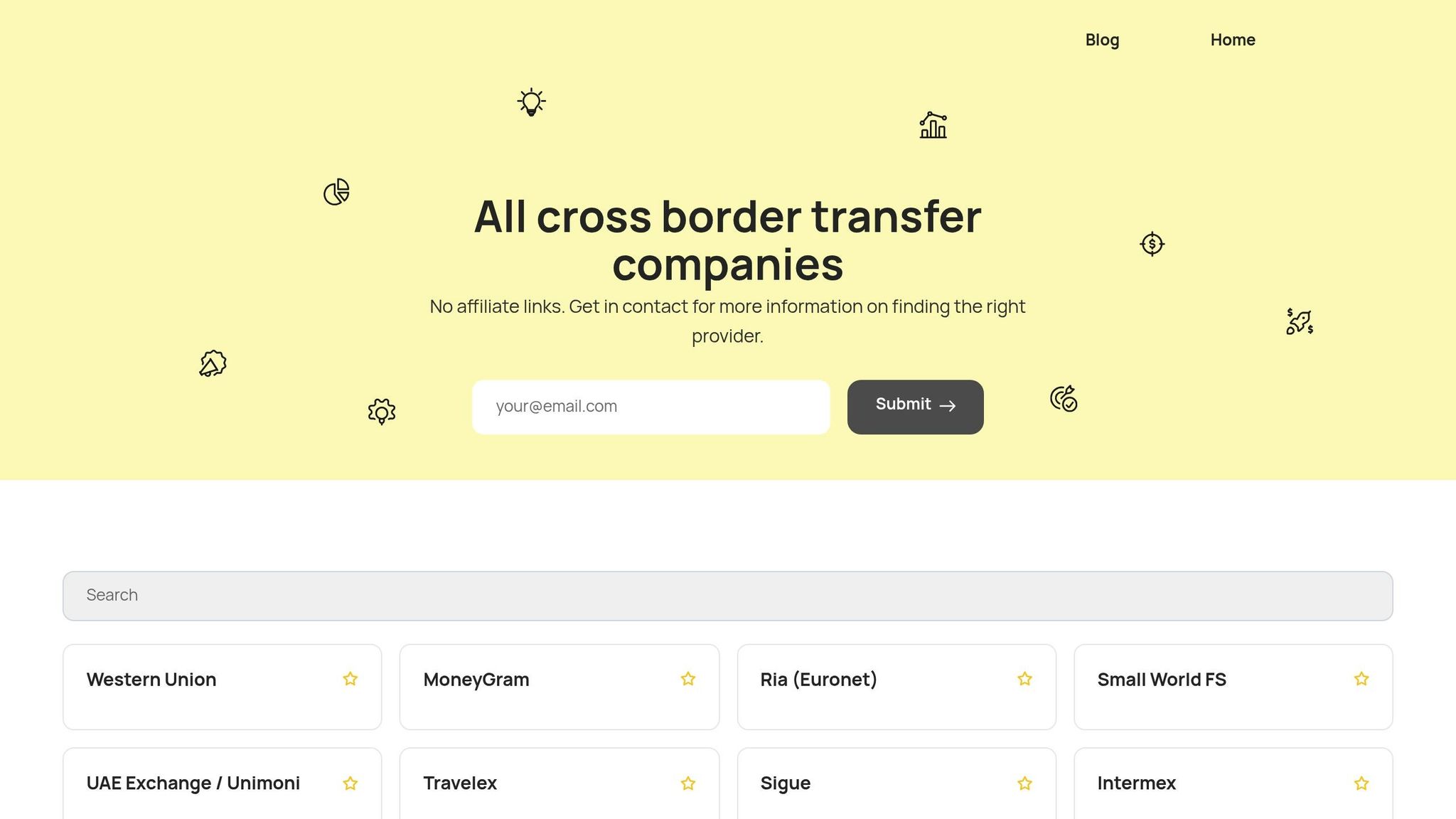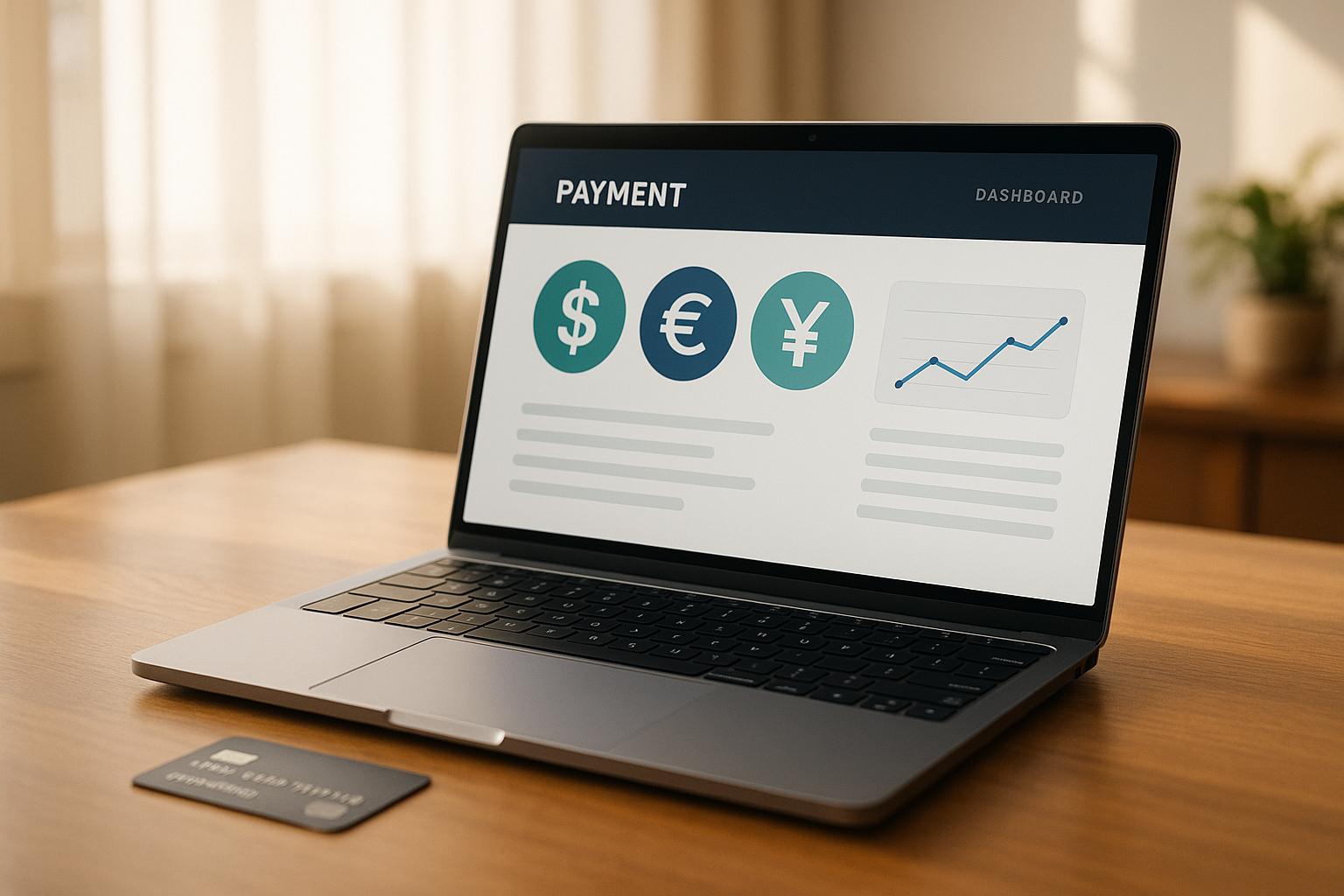Cross-border payments are slow, expensive, and complex. AI-powered routing changes that by analyzing real-time conditions to find the fastest and most cost-effective routes. Unlike older systems with fixed pathways, AI uses dynamic decision-making to bypass bottlenecks, improve compliance checks, and reduce fees.
Key Benefits:
- Faster Transfers: Payments now clear in minutes or hours, not days.
- Lower Costs: AI minimizes intermediary fees and optimizes currency conversions.
- Improved Reliability: Fewer failures and delays caused by manual processes.
- Real-Time Tracking: Transparency at every step of the payment process.
AI also integrates with technologies like blockchain, offering added security and efficiency. For U.S. businesses, this means better cash flow, fewer disruptions, and more predictable international transactions. Ready to modernize your payment system? Start by evaluating providers with advanced AI capabilities and proven results.
📽️ VIDEO | Can AI finally fix cross-border payments?
How AI-Powered Routing Fixes Delays
AI transforms the way routing decisions are made by addressing the shortcomings of fixed pathways. Unlike traditional systems that follow predetermined routes regardless of current conditions, AI-powered routing evaluates thousands of data points every second to determine the most efficient route for each transaction.
How AI Optimizes Payment Routes
AI systems are constantly evaluating factors like network conditions, bank processing speeds, currency exchange rates, and regulatory requirements across multiple countries. For instance, when a U.S. business sends a payment to an overseas supplier, AI analyzes these variables in real time to select the fastest and most cost-effective route.
What’s more, AI learns from past transactions, identifying quicker banks and avoiding routes prone to delays. This predictive capability makes the system smarter with every transaction it processes.
Here’s an example: If AI detects that a correspondent bank in London is overwhelmed on a Tuesday afternoon, it can instantly reroute payments through alternative paths to bypass the congestion. It even factors in compliance risks, selecting routes that minimize delays caused by additional regulatory checks.
Currency market fluctuations also play a role. AI can pinpoint the best time and route for currency conversion, helping businesses save on exchange rates while ensuring faster processing.
These real-time adjustments result in tangible improvements in speed, cost, and reliability.
Benefits of AI-Powered Routing
The impact of AI on cross-border payments is both measurable and transformative. Traditional payment systems, plagued by failures affecting up to 30% of online payments due to card declines, fraud checks, or inefficient routing, see significant improvements with AI.
Speed: Transactions that used to take 3-5 business days are now completed in minutes or hours. AI eliminates the trial-and-error routing of traditional systems, where payments often bounce between intermediaries before succeeding.
Cost Savings: Faster, more efficient routing reduces transaction fees, currency conversion costs, and the hidden expenses of delayed payments, such as strained supplier relationships or missed opportunities.
Reliability: AI reduces the issue of false flags on legitimate payments, which contribute to up to 25% of card declines in traditional systems. By better understanding transaction patterns and risks, AI ensures more payments succeed on the first attempt.
Additionally, AI systems are more resilient during system updates or changes. For example, when payment networks introduce new authorization rules, traditional systems often experience a temporary drop in approval rates by 5-10%. AI adapts quickly, maintaining higher success rates even during transitions.
Old vs. AI-Powered Routing Methods
A comparison between traditional and AI-powered routing methods underscores the advantages of AI:
| Aspect | Traditional Routing | AI-Powered Routing |
|---|---|---|
| Decision Making | Static, pre-set pathways | Real-time, dynamic routing |
| Processing Speed | 3-5 business days | Minutes to hours |
| Failure Rate | Up to 30% | Significantly reduced |
| Cost Efficiency | Higher fees, multiple intermediaries | Lower costs, fewer intermediaries |
| Adaptability | Manual updates needed | Automatic learning and adjustments |
| Transparency | Limited visibility | Real-time tracking and insights |
| Compliance Handling | Reactive, delays common | Predictive, avoids issues |
One of the most striking differences is transparency. Traditional routing often leaves businesses in the dark about where their payment is or why it’s delayed. AI-powered systems, on the other hand, provide real-time tracking and insights, giving businesses the tools to anticipate and address potential issues before they escalate. This proactive approach not only reduces stress but also fosters smoother operations.
Key Technologies Behind AI-Powered Routing
Several advanced technologies work together to make AI-driven routing systems highly efficient. These technologies form the backbone of systems that can make lightning-fast routing decisions, far surpassing the capabilities of traditional payment networks.
Smart Routing Algorithms
At the core of AI-powered routing are machine learning algorithms that adapt in real time to changes across global payment networks. These algorithms analyze vast amounts of data to determine the best path for each transaction, factoring in network conditions, costs, and compliance requirements.
They’re constantly learning - drawing insights from both successful and failed transactions - allowing them to update routes instantly to avoid delays. Dynamic scoring systems play a pivotal role by evaluating potential routes in real time. Each route is scored based on factors like speed, cost, compliance risk, and past performance. For instance, when transferring $50,000 from New York to Singapore, the system might analyze dozens of pathways through various banks, currency exchanges, and regulatory checkpoints, all in the blink of an eye.
These algorithms also account for time-sensitive variables, recognizing that optimal routes can change throughout the day. For example, the best path at 9:00 AM EST might differ from the one at 3:00 PM due to differences in bank processing loads, market activity, or regional business hours. By incorporating this temporal awareness, payments are routed during peak operational efficiency, paving the way for systems that can even predict future fluctuations.
Predictive Analytics and Big Data
Predictive analytics leverages historical transaction data to foresee potential delays and suggest alternative routes before problems arise. By analyzing patterns from millions of past transactions, these systems can pinpoint risks and make proactive adjustments.
Big data engines continuously monitor global payment flows, tracking metrics like average processing times between specific banks, seasonal transaction trends, and regulatory updates. This data feeds into predictive models that can forecast congestion or delays along specific routes.
These systems uncover hidden patterns that human operators might overlook. For example, they can predict delays caused by routine maintenance or identify that transactions over $25,000 to certain countries might face extra scrutiny during geopolitical events.
The system also integrates real-time data streams from currency markets, banking networks, and regulatory bodies. If a major bank encounters technical issues, the system can immediately reroute thousands of transactions to avoid bottlenecks. It even analyzes compliance trends, identifying which types of payments are more likely to trigger regulatory reviews. This allows time-sensitive transactions to be routed through channels with streamlined compliance processes while still meeting all legal requirements.
AI and Blockchain Integration
When AI meets blockchain technology, the result is unparalleled transparency and security in cross-border payments. Blockchain provides an unchangeable record of every transaction step, while AI ensures the most efficient routing within this transparent system.
Smart contracts execute AI-optimized routes automatically, offering real-time updates on payment status, location, and estimated completion times. Unlike traditional systems where payments can vanish into banking networks for days, blockchain-based systems keep all parties informed at every stage.
Blockchain also simplifies cross-border payments by cutting out many of the intermediaries that traditionally slow down transactions. AI can identify and route payments through blockchain networks that settle directly between banks, bypassing the costly and time-consuming processes of correspondent banking.
This combination also addresses settlement delays, a common issue in traditional payment systems. While conventional methods may take days to confirm final settlement, blockchain-enabled payments with AI routing can achieve this within hours, giving both senders and recipients greater certainty.
Additionally, cryptographic security built into blockchain systems works hand in hand with AI fraud detection to provide robust protection. AI continuously scans for suspicious activity, while blockchain ensures that once a legitimate transaction is recorded, it cannot be altered without proper authorization. Together, these technologies create a secure, efficient system that accelerates cross-border payments while reducing risks.
sbb-itb-165eed9
Impact of AI-Powered Routing on U.S. Businesses and Consumers
AI-powered routing is reshaping how U.S. businesses and consumers handle cross-border payments. By making transactions quicker, reducing costs, and offering greater clarity, these systems are transforming the payment landscape.
Faster Transactions and Reduced Fees
Gone are the days when international transactions took several days to process. With AI-powered routing, payments now move in minutes. These systems analyze multiple pathways in real time, choosing the fastest and most efficient routes while avoiding bottlenecks. This not only speeds up transfers but also ensures more predictable fees, cutting down on hidden costs - especially beneficial for frequent or high-value transfers.
Building Transparency and Confidence
One of the standout features of AI-driven systems is their ability to provide real-time updates at every step of a transaction. From initiation to settlement, users can track their payments and see a detailed breakdown of processing stages and associated fees upfront. Automated compliance checks further boost trust, ensuring every transaction adheres to regulatory standards. This level of transparency is a game-changer for businesses managing large international transfers and for consumers relying on timely remittances. It’s a win-win, especially as global transaction volumes continue to grow.
Handling High-Volume Transactions with Ease
For businesses managing large transaction volumes, AI-powered routing is a lifesaver. These systems automate batch processing and handle exceptions without the need for manual intervention, keeping everything running smoothly. They also adapt to fluctuations in transaction volume, maintaining reliable performance during busy periods. By balancing loads across different banking channels, AI ensures efficiency even during surges. This reliability allows businesses to scale their global operations confidently, without worrying about payment infrastructure holding them back.
Choosing the Right Provider for AI-Powered Cross-Border Payments
Why the Right Provider Matters
Picking the right provider is essential for smooth cross-border payments. With AI-powered routing becoming the norm, not all providers bring the same level of expertise to the table. Providers with advanced AI algorithms can reduce transaction delays by up to 42% compared to traditional systems. For U.S. businesses managing high transaction volumes or operating in industries where time is critical, this kind of efficiency can make all the difference. Delays or inconsistent performance during peak times can lead to bottlenecks that disrupt operations, emphasizing the need for a provider that offers speed, dependability, and cost control.
Using Cross Border Payments Companies as a Resource

Cross Border Payments Companies is a valuable tool for navigating the often-complicated payment provider landscape. It offers detailed profiles of providers, highlighting their AI capabilities, API offerings, and expertise in specific payment corridors. Unlike generic marketing material, this platform focuses on practical details. You'll find insights into actual performance, as well as the strengths and limitations of leading providers.
In May 2025, the growing role of blockchain and stablecoin providers was acknowledged, with these players being included in major rankings for cross-border payments. The directory has also expanded to include providers from Canada and Asia, offering a broader global perspective.
By translating technical details into actionable insights, this resource helps businesses make smarter decisions. With this information, you can evaluate providers based on their performance, cost transparency, and ability to scale with your needs.
Factors to Consider in a Provider
Transaction Processing Performance:
Look for providers with proven data showing faster transaction processing times. AI-powered systems often outperform traditional methods, offering significant time savings.
AI Algorithm Sophistication:
Ask about the AI technologies they use. Providers leveraging advanced methods like reinforcement learning or Deep Q-Networks for dynamic routing tend to deliver better results.
API Integration:
Ensure the provider offers APIs that integrate seamlessly with your systems for smooth data exchange and automation.
Cost Transparency and Predictability:
Choose providers with clear and upfront fee structures to avoid unexpected costs.
Geographic Coverage and Corridor Expertise:
Some providers specialize in specific regions or currency pairs. Check their performance in the payment corridors that matter most to your business and verify their infrastructure supports your growth plans.
Scalability and Volume Handling:
As your business grows, your transaction volume will too. Test providers to see how well their AI systems handle spikes in activity without sacrificing speed or reliability.
| Key Performance Indicator | Traditional Systems | AI-Powered Systems |
|---|---|---|
| Average Processing Time (hours) | 5.2 | 3 |
| Delay Reduction (%) | Baseline | 42% |
Conclusion: How AI Changes Cross-Border Payments
Key Takeaways
AI-powered routing is reshaping the way cross-border payments are handled. By tackling the delays caused by outdated and inefficient systems, AI uses real-time data to optimize payment pathways automatically, leading to noticeable improvements in speed and reliability.
Legacy systems often bog down transactions, but AI routing significantly reduces these delays. For U.S. businesses managing large transaction volumes, even minor gains in speed can translate into better cash flow, improved customer satisfaction, and streamlined operations.
AI routing also brings greater clarity and control over costs. Advanced algorithms identify the most cost-efficient routes, steering clear of hidden fees and unfavorable exchange rates - something manual or basic automated systems struggle to achieve.
Scalability is another standout benefit. Whether handling a few payments or a sudden surge in transaction volume, AI-powered systems adjust seamlessly without sacrificing performance. This adaptability is especially critical for businesses experiencing growth, as it helps prevent bottlenecks during busy periods.
Given these advancements, U.S. businesses should now consider upgrading their payment systems to stay ahead in the global market.
Next Steps for U.S. Businesses
The cross-border payments landscape is evolving quickly, and adopting AI-powered routing can streamline operations while giving businesses a competitive edge. To remain ahead, companies should evaluate their current payment systems and explore AI-enabled solutions.
Start by analyzing your transaction volumes, processing times, and cost structures. Identify recurring challenges such as delays or unexpected fees to create a clear picture of areas needing improvement.
Platforms like Cross Border Payments Companies offer valuable tools for comparing AI-enabled providers. These resources feature detailed profiles with performance metrics, API capabilities, and expertise in key payment corridors. Their regularly updated information can help businesses identify solutions that also incorporate technologies like blockchain.
When selecting a provider, prioritize elements like advanced AI algorithms, transparent fee structures, strong API integration, and proven results in your specific payment corridors. A reliable provider should offer detailed documentation outlining their optimization strategies.
Adopting AI-powered routing isn’t just about keeping up with the latest technology - it’s about gaining a competitive advantage. Faster, more reliable, and cost-efficient cross-border payments can fuel international growth and help businesses meet the ever-changing demands of their customers.
FAQs
How does AI-powered routing help reduce fees and improve currency conversions in cross-border payments?
AI-powered routing streamlines transactions by analyzing real-time data, such as exchange rates, processing expenses, and regulatory guidelines. By pinpointing the most efficient payment paths, it cuts down on unnecessary intermediaries, significantly reducing fees.
Additionally, these systems fine-tune the timing of currency conversions, ensuring transactions happen when exchange rates are at their best. This approach not only saves money but also ensures quicker and more dependable cross-border payments for businesses and individuals alike.
How does blockchain improve the security and efficiency of AI-powered cross-border payments?
Blockchain plays a key role in improving the security and efficiency of AI-driven cross-border payments. By enabling fast, transparent, and tamper-resistant transactions, it removes the need for traditional banking intermediaries. This not only cuts down on delays but also significantly reduces costs. Additionally, smart contracts streamline settlements, ensuring smoother and more automated processing.
Because blockchain operates on a decentralized system, it adds an extra layer of security. Transactions are recorded in a way that can't be altered, making them resistant to fraud and bolstering trust. As a result, cross-border payments become faster, safer, and more dependable for both businesses and consumers.
How can U.S. businesses choose the right AI-powered payment provider for their transaction needs?
When searching for the ideal AI-driven payment provider, U.S. businesses should prioritize platforms that leverage machine learning for tasks like real-time payment routing, fraud detection, and cost efficiency. These advanced tools can adjust to your specific transaction needs and volumes, enabling quicker and smoother cross-border payments.
It's also important to choose providers that offer clear, upfront details about fees, processing times, and compliance with both U.S. and international regulations. This transparency helps businesses match payment solutions to their operational demands while ensuring secure and seamless transactions across borders.


